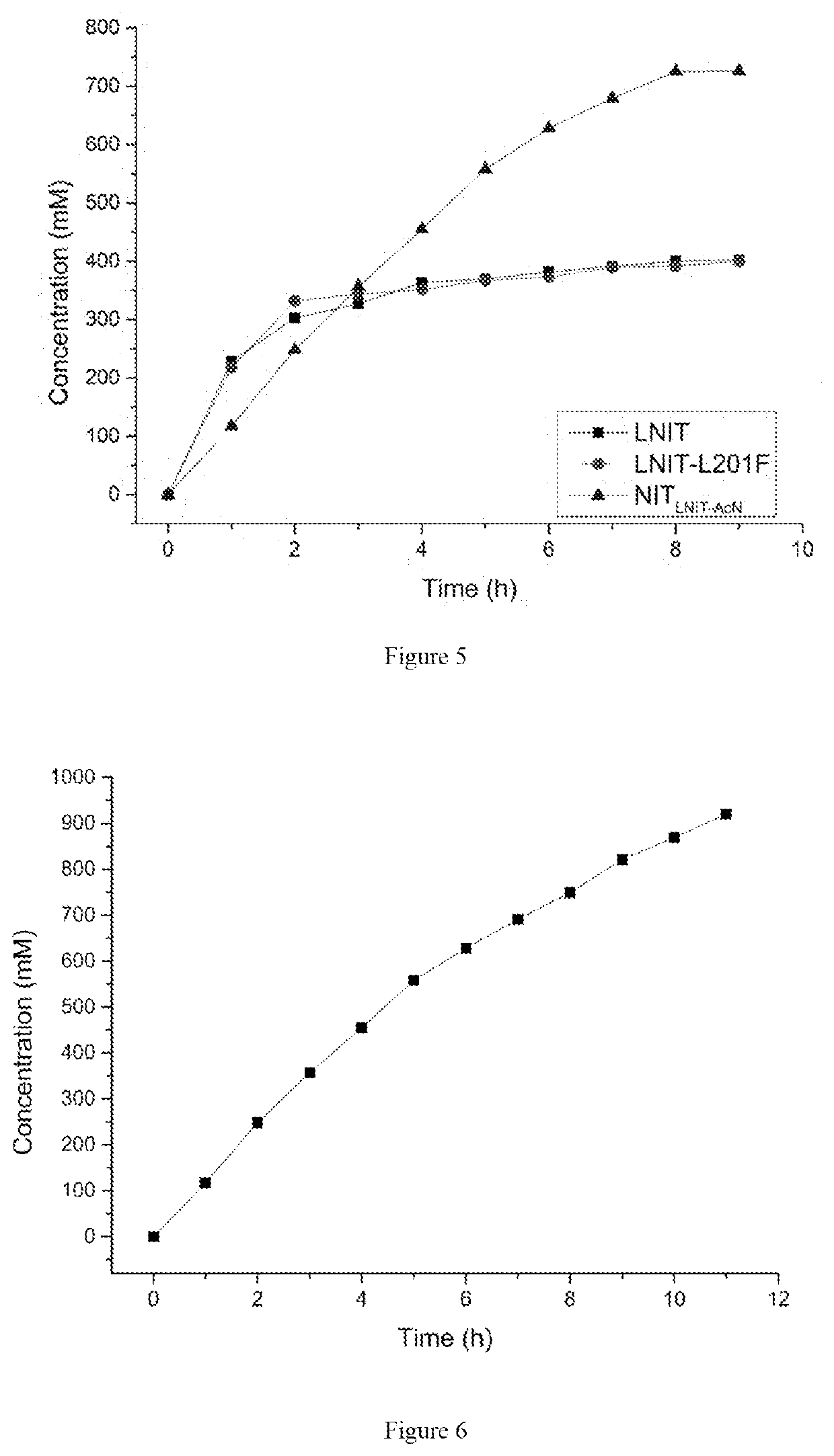Encoding genes of nitrilase mutants and application thereof
a technology of nitrilase and coding genes, which is applied in the field of encoding genes of nitrilase mutants, can solve the problems of large discharge of “three wastes”, serious environmental pollution, and high treatment cost of “three wastes” in the production process, and achieves the effects of increasing product tolerance, double conversion rate, and increasing the activity of nitrin-l201
- Summary
- Abstract
- Description
- Claims
- Application Information
AI Technical Summary
Benefits of technology
Problems solved by technology
Method used
Image
Examples
example 2
ion of Recombinant Expression Vector pET-28b(+)-LNIT5 and the Recombinant Strain
[0030]The recombinant expression vector pET-28b(+)-LNIT5 containing the nitrilase LNIT5 gene was synthesized by the total-synthetic method and via conventional operation of genetic engineering. The constructed expression vector pET-28b(+)-LNIT5 was transferred into a receptor strain, E. coli BL21 (DE3), which was then plated on a LB agar plate containing kanamycin (at the final concentration of 50 μg / mL) and cultured overnight at 37° C. The colonies grown on the plate were randomly selected, and the plasmid was extracted and identified by agarose gel electrophoresis to obtain the recombinant strain E. coli BL21 (DE3) / pET-28b(+)-LNIT5.
TABLE 1primer design tablePrimer namePrimer sequence (5′ to 3′)L201F-fCCGGACGTTCCGCAGTTTGGCGCAGGTGCGAATGL201F-rCATTCGCACCTGCGCCAAACTGCGGAACGTCCGGI-fACCTGGACGAAGAAGGTCGTCTGGATGTTAACACGCGTTCCI-rTTGTTAGCAGCCGGATCTCAGTGGTGGTGGTGGTGGTGCP-fTGAGATCCGGCTGCTAACAAAP-rACGACCTTCTTCGTCCA...
example 3
ion of Nitrilase LNIT5 Mutant
[0031]The expression plasmid pET-28b(+)-LNIT5 was used as a template, and the site-directed mutagenesis was carried out by amplification of the whole plasmid. The PCR system (50 μL) was as follows: 0.5-20 ng of the template, 10-15 pmol of each primer (L201F-f and L201F-r, whose sequences is seen in in table 1), 5×PrimeSTAR Buffer (Mg2+ plus), 0.2 mM dNTP, and 1.25 U PrimeSTAR HS DNA Polymerase. The PCR program was as follows: (1) pre-denaturation at 98° C. for 3 min; (2) denaturation at 98° C. for 10 s; (3) anneal at 60° C. for 5 s; (4) extension at 72° C. for 6.5 min, wherein steps (2)˜(4) were cycled 30 times; and (5) finally, extension at 72° C. for 5 min, preservation at 4° C. The PCR product was identified by agarose gel electrophoresis, digested with DpnI, and then introduced into the host strain E. coli BL21 (DE3), which was then plated on a LB plate containing 50 μg / mL kanamycin to obtain monoclones. The selected monoclonal plasmid was extracted,...
example 4
n of the Wild-Type or the Mutant-Type Nitrilase
[0035]The transformants E. coli BL21 (DE3) / pET-28b(+)-LNIT5, E. coli BL21 (DE3) / pET-28b(+)-LNIT5-L201F and E. coli BL21 (DE3) / pET-28b(+)-NITLNIT5-AcN obtained in example 2 and example 3 were respectively inoculated into LB medium, cultured at 37° C. for 10-12 hours, the resulting inocula were respectively inoculated to LB medium containing kanamycin (with the final concentration of 50 mg / L) with 2% incubating volume, amplified and cultured at 37° C. When OD600 of the culture medium reached 0.6-0.8, isopropyl-β-D-thiogalactopyranoside (IPTG) was added with the final concentration of 0.1 mM, and the bacteria solution was subjected to induced expression at 28° C. for 10 hours. The wet cells were harvested by centrifugation and washed with normal saline twice.
PUM
| Property | Measurement | Unit |
|---|---|---|
| concentration | aaaaa | aaaaa |
| concentration | aaaaa | aaaaa |
| pH | aaaaa | aaaaa |
Abstract
Description
Claims
Application Information
 Login to View More
Login to View More - R&D
- Intellectual Property
- Life Sciences
- Materials
- Tech Scout
- Unparalleled Data Quality
- Higher Quality Content
- 60% Fewer Hallucinations
Browse by: Latest US Patents, China's latest patents, Technical Efficacy Thesaurus, Application Domain, Technology Topic, Popular Technical Reports.
© 2025 PatSnap. All rights reserved.Legal|Privacy policy|Modern Slavery Act Transparency Statement|Sitemap|About US| Contact US: help@patsnap.com



